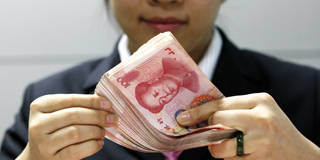In August 2015, the People’s Bank of China established that central parity of the renminbi's exchange rate against the US dollar would be set with reference to the previous trading day’s closing price. But that much-needed step toward a more flexible, market-driven exchange rate was quickly – and wrongly – abandoned.
BEIJING – On August 11, 2015, the People’s Bank of China (PBOC) established that the central parity of the renminbi’s exchange rate against the US dollar would be set with reference to the previous trading day’s closing price, within a 2% band. It was a bold step toward a more flexible, market-driven exchange rate. But the announcement of the reform caused the market to panic, triggering a 3% decline in the renminbi in just four trading days. So it was quickly abandoned.
That policy reversal, while understandable, is regrettable. For the rest of 2015, the PBOC struggled to prevent the renminbi from weakening. Having spent a huge amount of foreign-exchange reserves, it decided in February 2016 to introduce a new rule for setting the central parity rate.
According to the replacement rule, the central parity rate would take into account not just the previous trading day’s closing price, but also the “theoretical exchange rate” that would keep the index of the China Foreign Exchange Trade System, a 24-currency basket, unchanged over the previous 24 hours. In other words, whenever there was a change in the US dollar index, the PBOC would have to intervene in the foreign-exchange market to align the market-determined renminbi-dollar exchange rate with the theoretical exchange rate that kept the CFETS index stable.

BEIJING – On August 11, 2015, the People’s Bank of China (PBOC) established that the central parity of the renminbi’s exchange rate against the US dollar would be set with reference to the previous trading day’s closing price, within a 2% band. It was a bold step toward a more flexible, market-driven exchange rate. But the announcement of the reform caused the market to panic, triggering a 3% decline in the renminbi in just four trading days. So it was quickly abandoned.
That policy reversal, while understandable, is regrettable. For the rest of 2015, the PBOC struggled to prevent the renminbi from weakening. Having spent a huge amount of foreign-exchange reserves, it decided in February 2016 to introduce a new rule for setting the central parity rate.
According to the replacement rule, the central parity rate would take into account not just the previous trading day’s closing price, but also the “theoretical exchange rate” that would keep the index of the China Foreign Exchange Trade System, a 24-currency basket, unchanged over the previous 24 hours. In other words, whenever there was a change in the US dollar index, the PBOC would have to intervene in the foreign-exchange market to align the market-determined renminbi-dollar exchange rate with the theoretical exchange rate that kept the CFETS index stable.